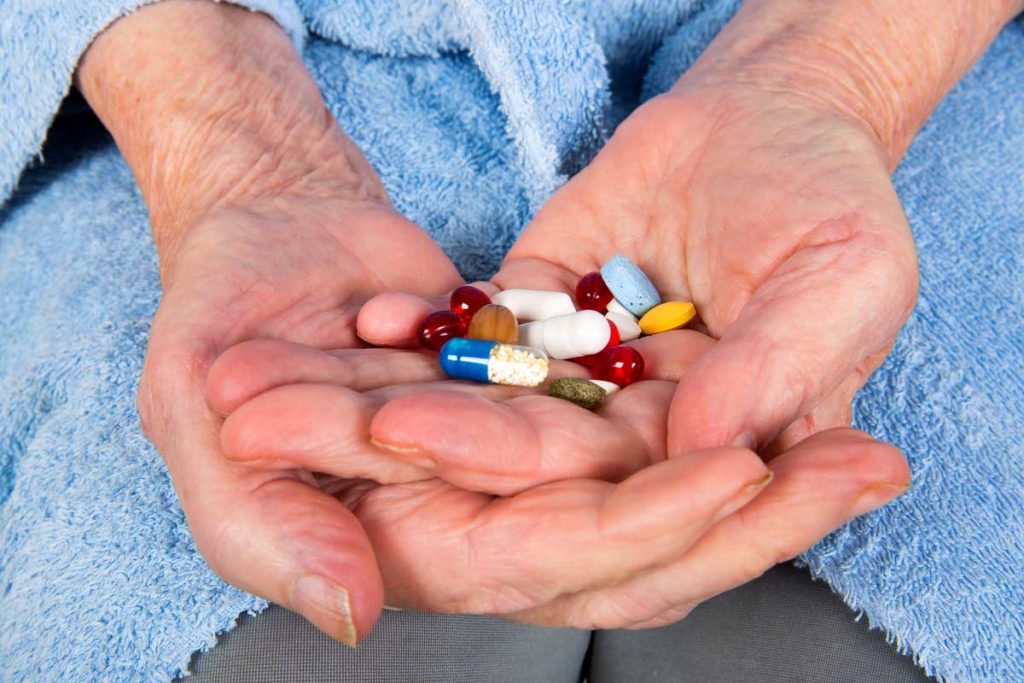Research published in The BMJ adds that chronic pain conditions are more prevalent for individuals 65 years old and older, with 52.8 percent reporting that they’ve experienced some type of pain within the previous 30 days. This pain can result in problems with mobility, increased risk of falls, and even trouble sleeping.
These numbers are causing some healthcare professionals to encourage prescription providers to really consider whether opioids are the best course of action for patients in pain.
Other effects of enduring chronic pain for the elderly are more mental in nature, including the development of issues related to depression, anxiety, feeling isolated, and activity avoidance. Essentially, chronic pain impacts all areas of one’s life, which is why many are now turning to opioids in an effort to ease it.
Opioid Use Among the Elderly
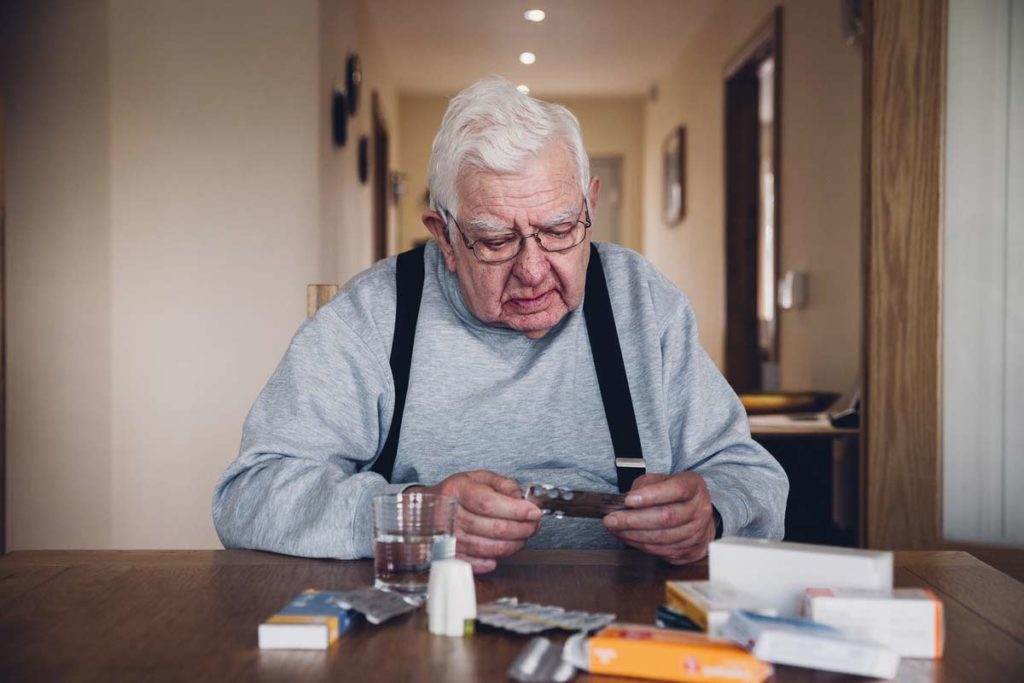
The number of elderly patients receiving opioid prescriptions increased nine times between 1996 to 2010 according to Psychiatric Times. And more than one in three (35 percent) of individuals over the age of 50 report that they have misused this particular category of drug in the last 30 days, causing the hospitalization rate for misuse to increase five-fold over the last two decades.
These numbers are causing some healthcare professionals to encourage prescription providers to really consider whether opioids are the best course of action for patients in pain. For instance, U.S. Pharmacist urges healthcare officials to “be cautious” when prescribing opiates to the elderly, partially because of age-related renal function decline, prohibiting their bodies from effectively clearing them from their systems.
However, opioids have other effects on the elderly, some of which are physical in nature and others which are more mental.
Physical Effects on Seniors
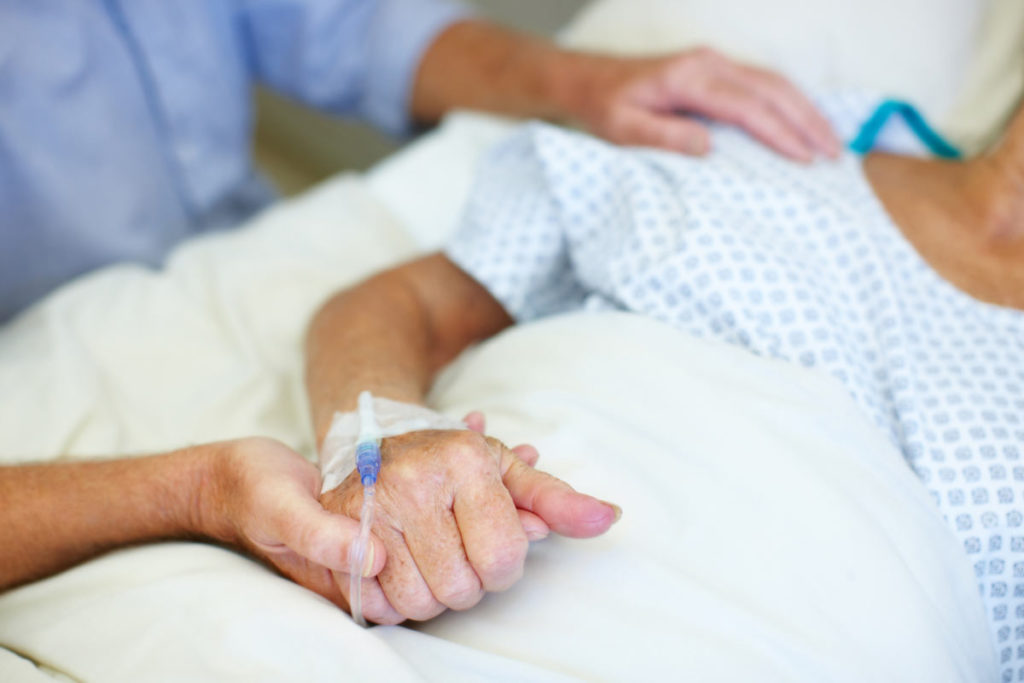
Although opioids are prescribed for positive reasons—as in, to help individuals ease or alleviate their pain—this class of drugs often has unintended physical consequences for the elderly.
Nausea
One of the most common and most significant negative physical side effects of opiate use in seniors is nausea, according to research published in Clinical Interventions in Aging. This uncomfortable response is partially caused by the body detecting the opioids in the blood, which initiates a vomiting reflex.
However, sometimes it is the impact opiates have on the part of the ear responsible for balance (the vestibular apparatus) or their effect on the gastrointestinal system that is to blame.
When these jerky contractions occur due to taking opiates, it is still questionable as to whether opiate receptor blockers like the drug naloxone can effectively reverse this effect.
Constipation
This research further states that another rather common side effect is opioid-induced constipation, with some studies finding that almost one-half of all hospice patients on opiates (48 percent) struggle with this issue.
According to an article published in Drugs & Aging, this physical condition is “often underrecognized and undertreated in the elderly.” There’s also a concern about using laxatives in the elderly as their effectiveness has not been totally proven for treating opioid-induced constipation.
Urinary Issues
Another negative side effect of opiate use in the elderly is urinary retention, or the inability to empty the bladder completely. This is sometimes caused by build-up of opiates in the body, more so when the drug is not used appropriately, according to one review published in the International Journal of Molecular Science. Other times, it occurs because of decreased liver and kidney function. If left untreated, this renal toxicity could lead to acute kidney injury and, potentially, renal failure.
Itching
Technically called ‘pruritus,’ severe itching of the skin occurs in as many as one in ten opiate users, according to the Clinical Interventions in Aging research. Pruritus is more common in the elderly anyway, according to the Mayo Clinic, and even though it normally disappears within a week of starting the opiate-based drug, it can be very uncomfortable in the meantime.
Respiratory Depression
The University of Wisconsin Hospital & Clinics explains that opioids can impact breathing rate, volume (the amount of air the lungs are able to inhale and exhale), and tidal exchange (how well the lungs can exchange oxygen and carbon dioxide). The result is irregular or slower rates of breathing, two concerns that are especially problematic when the elderly individual is sleeping as there is normally reduced sensitivity to carbon dioxide during this time already. For supplemental oxygen supply, it is common to use a portable oxygen concentrator.
Increased Pain Sensitivity
While opiates are prescribed to help individuals better deal with pain, sometimes they have the opposite effect and actually increase sensitivity to pain sensations. This is called opioid-induced hyperalgesia and the sensitivity can appear in the form of the original underlying pain, according to researchers from the Centers for Pain Management. Or, it may involve the presence of pain that is different from the one for which the drug was originally prescribed.
Jerky Muscle Contractions
Research published in the Journal of Neurology, Neurosurgery & Psychiatry indicates that, when there is long-term use of opiates, somewhere between 2.7 and 11 percent of users will experience myoclonus, a neuroexcitatory side effect that consists of spasmodic, jerky contraction of the muscles.
The National Institute of Neurological Disorders and Strokes shares that these types of contractions are similar to the ones experienced when you have the hiccups or if you jump as you start to fall asleep.
Additionally, when these jerky contractions occur due to taking opiates, it is still questionable as to whether opiate receptor blockers like the drug naloxone can effectively reverse this effect.
Increased Risk Of Falls
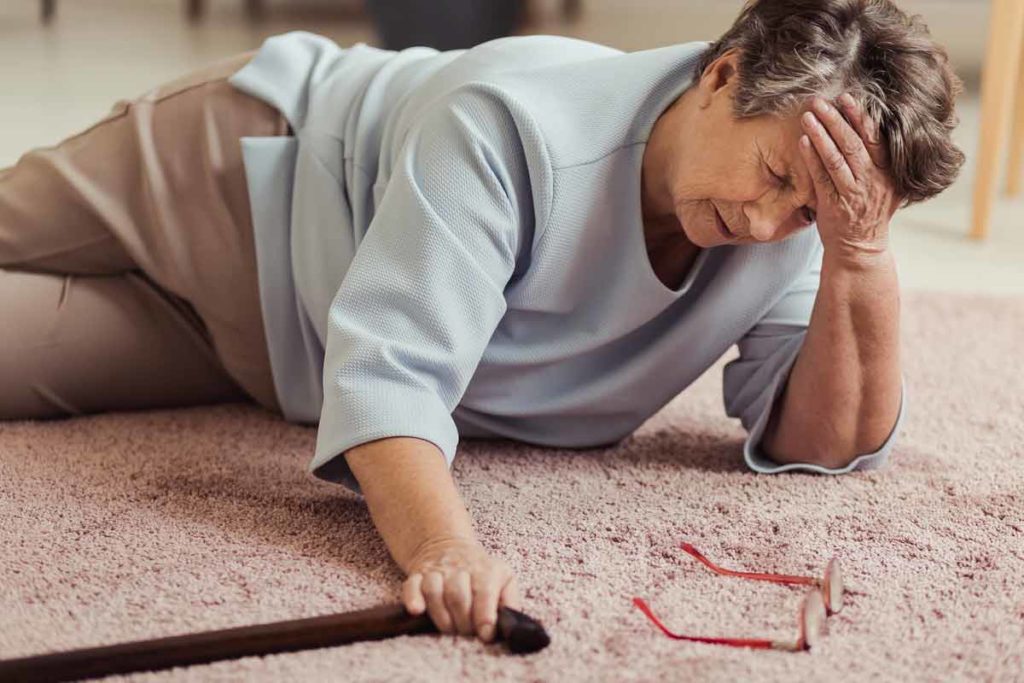
The risk of falls is already elevated for the elderly. The National Council on Aging reports that one out of every four Americans 65 or older falls each and every year, making it responsible for one emergency room visit every 11 seconds and one death every 19 minutes for this segment of the population.
But research published in the Canadian Medical Association Journal (CMAJ) highlights that this risk is even greater for elderly who are taking opiates as they are 2.4 times more likely to fall than to experience any other type of injury.
Diminished Bone Density
MedlinePlus says that as we age, we also lose bone mass and density, making this especially troublesome for women in their post-menopause years. Research in Therapeutics and Clinical Risk Management has found that long-term opiate use can potentially increase osteoporosis risk as well.
This effect is both direct and indirect by interfering with bone remodeling and turnover processes, leading to opioid-induced osteoporosis and, sometimes, opioid-associated bone fractures.
Impaired Sexual Performance
In May 2018, the University of Michigan’s National Poll on Healthy Aging released its Let’s Talk About Sex report that revealed that for adults between the ages of 65 and 80, 54 percent of those with romantic partners are sexually active.
Opioid use can potentially interfere with this intimate act, according to Medscape. Men who are being treated for back pain with opiates are 50 percent more likely to be treated for erectile dysfunction as well.
How Opioids Impact the Elderly Mentally
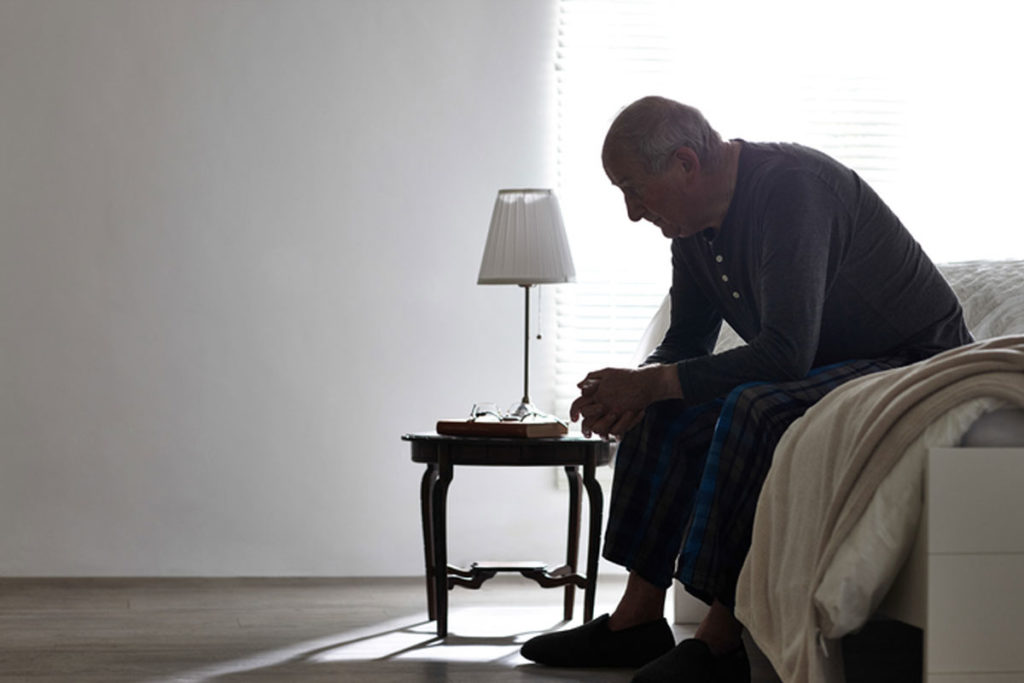
As if all of these physical side effects of opiate use for the elderly weren’t bad enough, there can be negative mental consequences too.
Though it’s unclear which usually comes first—the opioid misuse or the depression—this issue can be even more critical for the elderly.
Cognitive Impairment
Read the label on the side of a prescription opiate bottle and it will tell you that taking this type of drug may cause cognitive impairment. This is why you should take extra care when participating in certain activities, such as driving or operating heavy equipment.
However, Medscape adds that when it comes to the elderly specifically, both short and long-term opiate use can result in “deficits in executive functions, attention, concentration, recall, visuospatial skills, and psychomotor speed.”
Dementia
The National Institute on Aging reports that dementia, which is “the loss of cognitive functioning—thinking, remembering, and reasoning—and behavioral abilities to such an extent that it interferes with a person’s daily life and activities,” impacts as many as one-half of all individuals 85 years old and older. Research published in the Journal of the American Geriatrics Society says that individuals who use opioids have slightly higher dementia risks than those who don’t use this type of drug.
Depression
Some studies have connected opioid misuse with increased levels of depression. Though it’s unclear which usually comes first—the opioid misuse or the depression—this issue can be even more critical for the elderly. Mental Health America reports that two million of the 34 million older Americans already suffer from depression on some level.
Potential Signs of Opioid Addiction
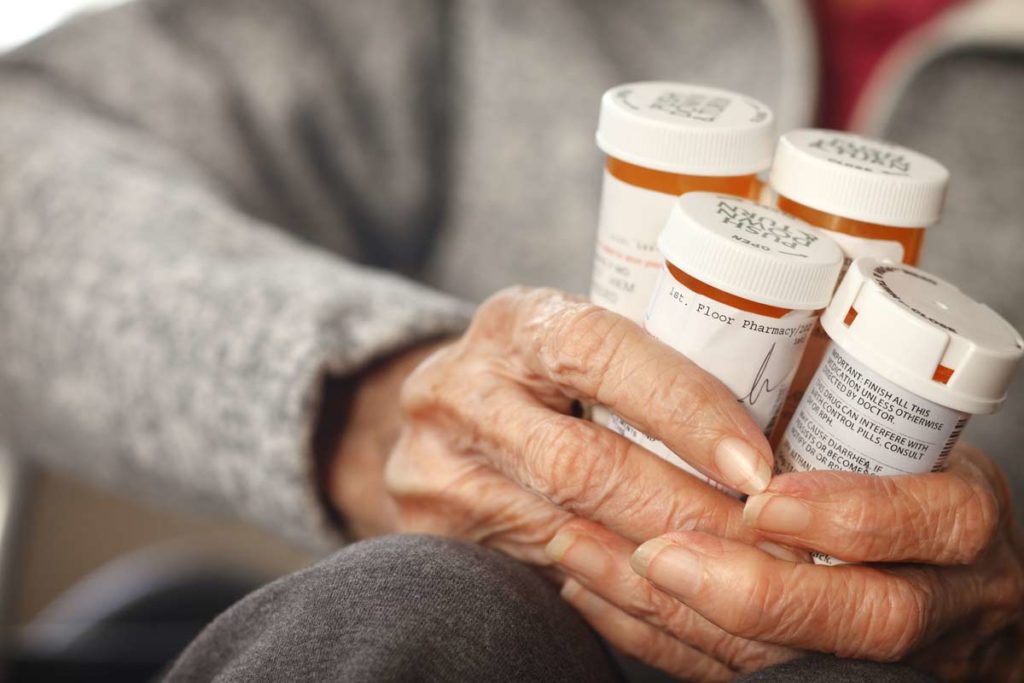
How can you tell if the elderly person in your life could potentially be addicted to prescription opioids? The University of Michigan says that this type of addiction often presents with these types of signs:
Withdrawal from social and recreational activities once enjoyed
- Opiate use or dosage increases, yet function continues to decline
- The opiate is used longer than originally prescribed (note that very few patients require more than one week of opiate use)
- The medication is being taken for reasons other than pain, such as when the person is feeling anxious, bored, or depressed
- Use of the opiate results in feeling high, signifying that too much is likely being taken
- The individual wants to decrease opiate use, but is unable to do so on his or her own
- An excessive amount of time is spent procuring opiates or the person seeks out other drugs if the opiates cannot be secured
- Having strong urges or cravings for opiates despite being aware of their negative consequences
- Withdrawal from social and recreational activities once enjoyed
- Engaging in reckless behaviors more frequently
- Experiencing withdrawal symptoms such as diarrhea, sweating, and moodiness if the drug is not taken in a consistent and timely manner
What to Do if Opioid Addiction is Suspected
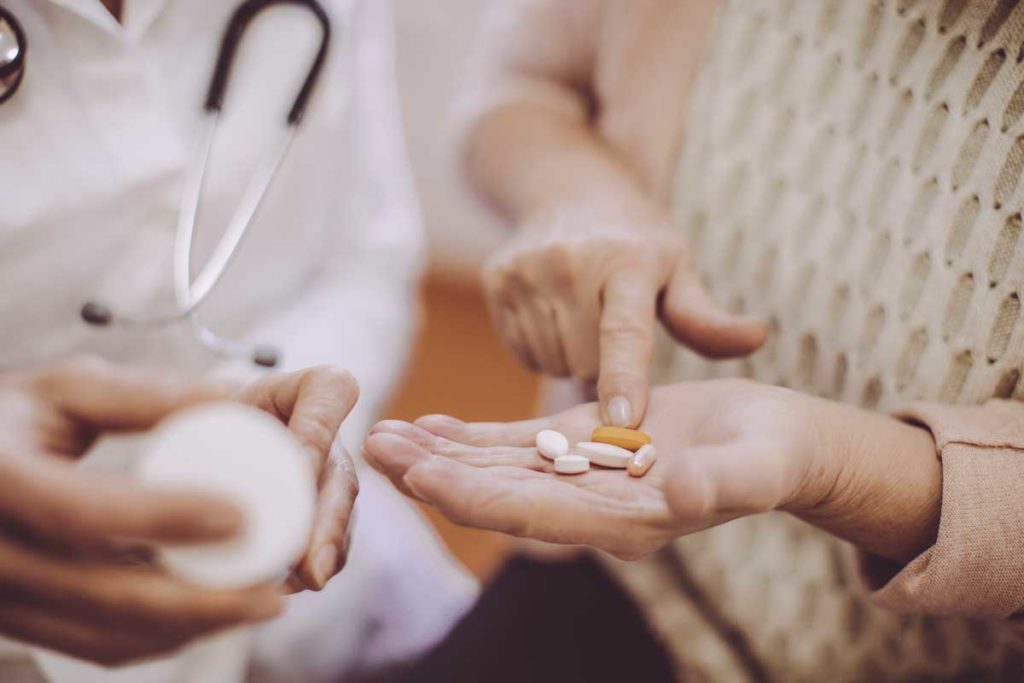
If you suspect that you (or an elderly loved one) may have a prescription opiate addiction, there are a few things you can do to overcome this issue and start to lead a happier, healthier life again.
In Opioid Addiction Treatment: A Guide for Patients, Families and Friends, the American Society of Addiction Medication (ASAM) shares that the first step toward recovery is for the individual to seek help, while the second step is to find a healthcare professional who can assess the level of addiction and develop an effective treatment plan based on the patient’s needs.
Depending on the severity of the addiction, this treatment may be outpatient, intensive outpatient (or require partial hospitalization), or inpatient at an addiction treatment center or hospital, according to ASAM. Additionally, treatment generally consists of taking medications to help ease withdrawal symptoms and counseling to begin to address any issues that may be contributing to the opiate addiction, such as having poor coping skills or low self-esteem.
If you’re a family member or friend of someone with the addiction, the ASAM stresses that you hold a critical role in the recovery process and that you can help best by first taking the time to learn as much as you can about the issue at hand. You can also provide effective recovery support by encouraging your elderly loved one to avoid any person or situation that would likely trigger his or her opiate use.
Natural pain-relieving alternatives for the elderly
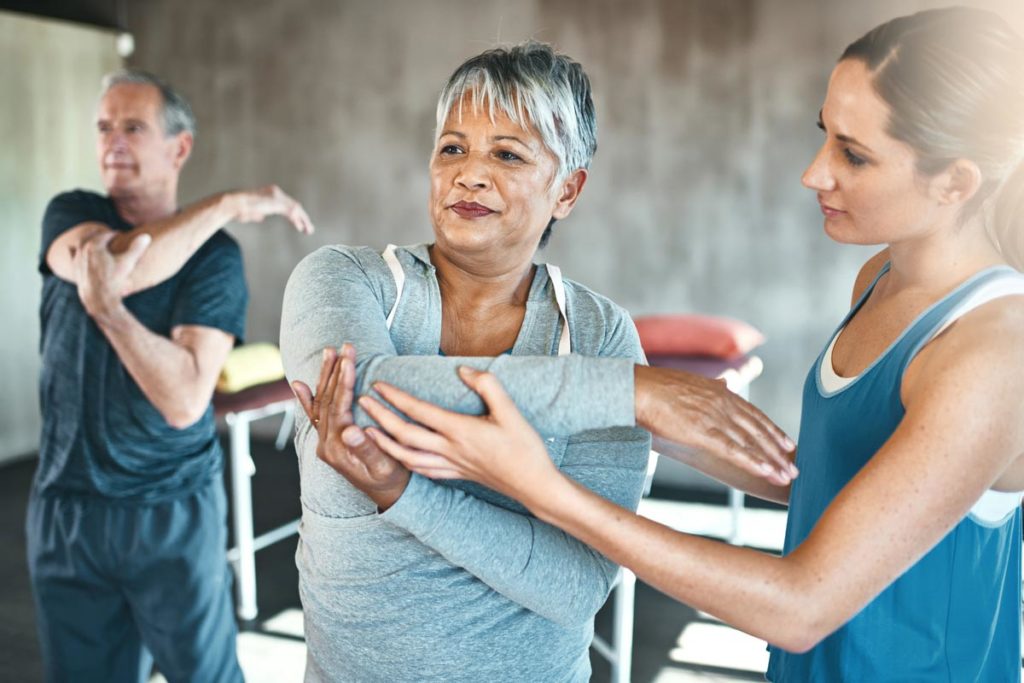
Because of all of the issues associated with opioid use and the elderly, U.S. Pharmacist recommends that older individuals manage their pain by using other, nonpharmacologic therapies whenever possible. Some of the options this organization recommends include:
Relaxation Techniques
Psych Central shares that being in pain results in increased muscle tension, which then intensifies the pain. Thus, practicing relaxation techniques such as relaxing your muscles by going through them systematically (for example, from head to toe or toe to head) can help reduce the pain.
Meditation is another relaxation technique that works to relieve pain by increasing pain thresholds. You can check with local healthcare organizations to see if they offer meditation classes, but there are also apps available that can be used for this purpose as well, such as the Mindfulness app and the Headspace app. This makes it possible to increase relaxation anytime and anywhere you’d like.
Meditation is another relaxation technique that works to relieve pain by increasing pain thresholds.
Self-Hypnosis
Psych Central adds that hypnosis can sometimes ease pain either by causing a distraction, by altering perception of the pain, or by numbing the area of the body where the pain is currently being felt. If you’re interested in taking this route, the Hypnosis Training Academy shares that you can achieve self-directed hypnosis by following six steps:
- Find someplace quiet or with soothing music. Plan to be there no longer than 15 minutes and tell yourself out loud that your trance will end when this time is up. Alternatively, you can also set an alarm to ensure that you don’t go over this limit.
- Be clear about your reason for self-hypnosis. For instance, your reason may be to successfully ease your pain without relying on opiates. Write it down and say it out loud.
- Relax by focusing on your breathing. Breathe slowly, inhaling through your nose and exhaling through your mouth.
- Take your mind deeper into the hypnosis. Visualize yourself walking down stairs, counting each step and becoming more relaxed the further you go.
- Focus on the change you want. Repeat your intention or visualize yourself overcoming the issues you face using images such as hurdles falling in front of you or seeing your issues float freely away.
- Exit the trance. Count backwards from 10 to 1 while telling yourself that you’re exiting the trance once you reach 1. You can also have your alarm sound or just wait and come out of the trance naturally.
If you struggle with this or want a more guided approach, there are a few apps that offer this option, such as Chronic Pain Relief and Pain Relief Hypnosis (available for both iOS and Android).
Psychiatric Therapy
Psychiatric therapy can be extremely beneficial when dealing with pain-based conditions because the pain may result or intensify due to feelings associated with isolation, worthlessness, or depression, according to Psychiatric Times.
However, by engaging in psychiatric therapy with a healthcare professional who specializes in pain management, the elderly patient is able to find healthier ways to deal with the pain and any other conditions that coexist with it. And it’s even better if this mental health professional works coordinates treatment with the individual’s medical professionals (physicians and other medical care providers).
To find one near you, Psychology Today offers an online chronic pain psychiatrist search. All you have to do is enter your city or zip code and you’re supplied a list of providers in your area. Along with getting their phone number and address, you can learn more about their approaches, qualifications, specialties, and costs.
Heat Applications
Healthline shares that heat helps with pain by improving blood flow to the affected area. There are two types of heat therapy you can do in the comfort of your own home:
- Dry heat – heating pads, dry heating packs, saunas
- Moist heat – steamed towel, moist heating packs, hot baths
If the pained area is relatively small, Healthline suggests using options that can direct heat to that specific area, such as heating pads or steamed towels. However, if the pain is all over, as is the case in some chronic pain conditions, saunas and hot baths will likely provide the best results.
Additionally, the amount of time used with each one depends largely on how severe the pain is. If it is fairly minor, 15 to 20 minutes may be enough to provide relief, but for pain more moderate to severe, 30 to 120 minutes may be necessary.
Finally, Healthline says that heat therapy is not advised for individuals with diabetes, dermatitis, vascular diseases, deep vein thrombosis (DVT), or multiple sclerosis (MS).
Cold Massage
In some cases, cold may provide more relief than heat, and one way to for incorporate coolness into your pain management plan is to engage in ice massages. Ice massage works by slowing inflammation and swelling, numbing sore tissues, and interrupting the pain-spasm reaction, according to Spine-health.
Generally, this option works best within the first 24-48 hours after the injury occurs and, though you can do it with individual ice cubes, Spine-health recommends using larger chunks of ice, such as those frozen in a cup and then removed for the actual massage session.
For best results, the ice should be applied gently in a circular motion (always keep it moving so the ice doesn’t injure the skin due to overexposure) and avoid the spine if the massage is being conducted on the back. This type of therapy can be provided 2-5 times per day, but no more than 5 minutes at a time, according to Spine-health.
Spine-health adds that this type of pain management therapy should be avoided by certain people, including elderly individuals with rheumatoid arthritis, Raynaud’s Syndrome, or cold-allergic conditions. It also should not be conducted on those who are paralyzed or have areas where they’re unable to feel sensation.
Electrical Nerve Stimulation
Research has found that electrical nerve stimulation is sometimes effective at treating a number of chronic pain-based conditions, such as those related to musculoskeletal issues and post-operative pain. Often referred to as TENS (transcutaneous electrical nerve stimulation) units, these devices work by activating sites in the spinal cord and brainstem that utilize pain-related receptors, and also by influencing different receptors to create an analgesic effect.
TENS units can be purchased outright, but you can also be prescribed one by a medical professional, in which case your insurance may cover the cost of the unit. Check with your individual provider directly to see it’s within your specific plan.
Physical Therapy
The Centers for Disease Control and Prevention reports that physical therapy often helps ease chronic pain conditions such as hip and knee osteoarthritis, lower back pain, and fibromyalgia. The effects can sometimes be long-lasting as well, with some studies showing pain improvements for as many as six months.
This option can get expensive, but some insurances will cover at least a portion of the bill. Check with your individual carrier to see if your policy offers this provision. If not, you can always contact local physical therapy practices and see if they provide any discounts for cash-paying patients.
Non-opioid Medications
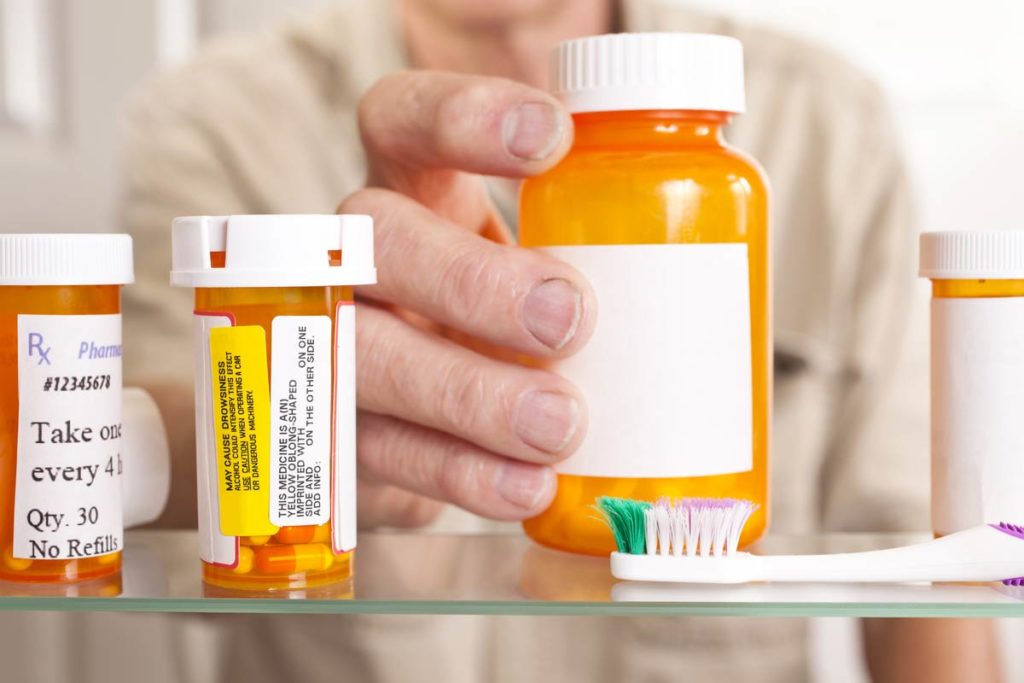
If medications are prescribed to the elderly for chronic pain conditions, U.S. Pharmacist suggests that they not be opioid-based. Drugs that fall into this category include antidepressants, antiarrhythmics, anticonvulsants, tranquilizers, and regional anesthesia.
You can also provide effective recovery support by encouraging your elderly loved one to avoid any person or situation that would likely trigger his or her opiate use.
Knowing this up front can help you have a frank conversation with your healthcare provider if he or she tries to give you an opiate prescription. Share your concerns with taking this approach and ask for alternative options suitable for your specific condition.
Safe Opioid Use
If you suspect that you (or an elderly loved one) may have a prescription opiate addiction, there are a few things you can do to overcome this issue and start to lead a happier, healthier life again.
In Opioid Addiction Treatment: A Guide for Patients, Families and Friends, the American Society of Addiction Medication (ASAM) shares that the first step toward recovery is for the individual to seek help, while the second step is to find a healthcare professional who can assess the level of addiction and develop an effective treatment plan based on the patient’s needs.
Depending on the severity of the addiction, this treatment may be outpatient, intensive outpatient (or require partial hospitalization), or inpatient at an addiction treatment center or hospital, according to ASAM. Additionally, treatment generally consists of taking medications to help ease withdrawal symptoms and counseling to begin to address any issues that may be contributing to the opiate addiction, such as having poor coping skills or low self-esteem.

If you’re a family member or friend of someone with the addiction, the ASAM stresses that you hold a critical role in the recovery process and that you can help best by first taking the time to learn as much as you can about the issue at hand. You can also provide effective recovery support by encouraging your elderly loved one to avoid any person or situation that would likely trigger his or her opiate use.
